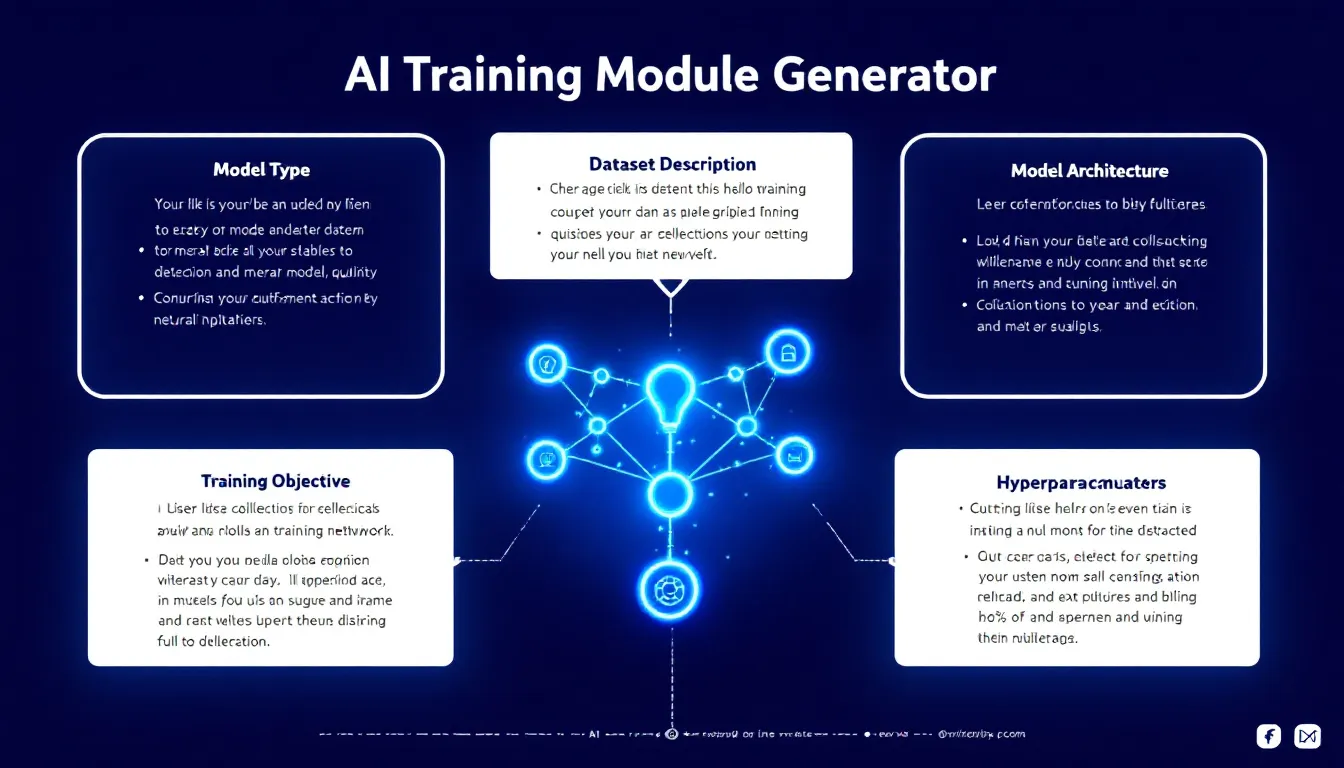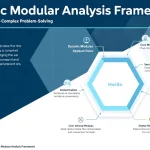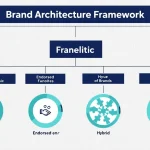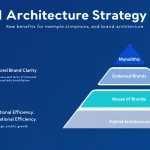AI Training Module Generator
Generating module...
Is this tool helpful?
How to Use the AI Training Module Generator Effectively
This AI Training Module Generator simplifies creating tailored machine learning training modules. Below are detailed instructions to help you fill in each field correctly for the best results:
1. Type of AI Model
Specify the neural network type suited for your task. Here are two example inputs different from the defaults:
- Graph Neural Network (GNN) for social network analysis
- Transformer with hierarchical attention for document classification
2. Dataset Description
Provide clear details that describe your dataset’s size, format, and domain. Try these examples:
- Satellite images: 10,000 multispectral images, 512×512 pixels, annotated for land use categories
- Sensor time series: 2 years of IoT device readings, 100Hz sampling rate, including temperature and humidity
3. Training Objective
Clarify the goal your model should achieve. Sample inputs:
- Binary anomaly detection in network traffic data
- Regression to predict housing prices based on economic indicators
4. Model Architecture (Optional)
Describe the neural network layout if you want to customize it further. Example inputs:
- 4 Transformer encoder layers with positional encoding and layer normalization
- Convolutional autoencoder with mirrored encoder-decoder structure and dropout
5. Hyperparameters (Optional)
Set training specifics to fine-tune your model. Examples include:
- Dropout rate: 0.3, Adam optimizer with beta1=0.9, beta2=0.999
- Batch size: 256, learning rate decay by 0.95 every 500 steps, weight decay = 0.0005
Introduction to the AI Training Module Generator
The AI Training Module Generator automates crafting custom training scripts for machine learning models. By entering your model and dataset specifications, it generates efficient, ready-to-use code that integrates best practices in neural network design and training.
This tool accelerates your workflow by reducing manual coding efforts and ensures consistency across training modules, making it easier to develop, reproduce, and adapt AI models tailored to your unique problems.
Core Benefits of Using This AI Training Script Generator
- Speeds Up Development: Generate complex model training scripts in minutes instead of days.
- Integrates Proven Architectures: Applies validated neural network designs and hyperparameter choices.
- Minimizes Errors: Validates inputs and parameter compatibility to prevent common pitfalls.
- Ensures Reproducibility: Produces clear, well-documented code for consistent experiments.
- Supports Multiple Frameworks: Creates code compatible with TensorFlow, PyTorch, and Keras.
Practical Usage of the AI Training Module Generator
You use this tool by filling out a simple form with details about your AI project. After submission, it processes your input on the server and returns a complete training module tailored to your specifications.
This module includes:
- Model initialization scripts following your chosen architecture
- Data preprocessing steps matching your dataset description
- Training loops with your specified objectives and hyperparameters
- Appropriate loss functions and evaluation metrics based on the training goal
Example Practical Scenarios
1. Environmental Sound Classification
- Input: Audio clips dataset with 20,000 samples of urban sounds
- Output: Training script with a CNN-RNN hybrid model, data augmentation, and RMSProp optimizer
2. Customer Churn Prediction
- Input: Customer transactional data with 100K rows and 30 features
- Output: Feedforward neural network training module using dropout, batch normalization, and focal loss function for class imbalance
3. Disease Progression Forecasting
- Input: Longitudinal health records over 5 years with mixed numerical and categorical data
- Output: Hybrid LSTM with attention layers training script including early stopping and learning rate scheduling
Understanding the Mathematical Concepts Behind the Generated Training Modules
The generated code incorporates essential mathematical principles that drive effective AI model training.
- Gradient Descent Optimization: Updating parameters using gradients to minimize loss functions.$$\theta_{t+1} = \theta_t – \eta \nabla_\theta J(\theta_t)$$
- Adam Optimizer Calculations: Combines adaptive learning rates with momentum.$$m_t = \beta_1 m_{t-1} + (1-\beta_1)g_t$$
- Cross-Entropy Loss for Classification Tasks: Measures prediction accuracy of probability outputs.$$L = -\sum_{i=1}^n y_i \log(\hat{y}_i)$$
Problem-Solving Features of the AI Training Module Generator
1. Optimized Neural Network Design
The tool suggests network architectures based on your input type, balancing complexity and efficiency. For example, it automatically selects LSTM layers tailored to sequential data or CNN blocks fine-tuned for image tasks.
2. Adaptive Hyperparameter Selection
The generator recommends training parameters like learning rates, batch sizes, and regularization based on data properties and model complexity. For example:
- For a medium-sized transformer model: learning rate 0.0005, batch size 64, weight decay 0.01
- For a recurrent model handling long sequences: gradient clipping threshold of 1.0 and dropout rate of 0.2
Common Use Cases and Applications
1. Autonomous Driving Perception Systems
- Dataset: LiDAR scans and camera images
- Generated Training Module: Multi-modal deep learning model combining CNN and point cloud processing layers
2. Sentiment Analysis for Social Media
- Dataset: Tweets in multiple languages
- Generated Training Module: Transformer-based classifier with multilingual embeddings and tokenization
3. Energy Consumption Forecasting
- Dataset: Hourly smart meter readings from residential buildings
- Generated Training Module: Hybrid CNN-LSTM architecture with attention mechanism for temporal patterns
Frequently Asked Questions About the AI Training Module Generator
What AI model types can I generate?
You can generate a wide variety of models including CNNs, RNNs, Transformers, autoencoders, and hybrid architectures that combine these designs.
Can I modify the generated training code?
Yes, the output code is modular with detailed comments, allowing you to customize layers, parameters, or extend functionality as needed.
Does the tool adjust for different dataset sizes?
It automatically adapts model and training parameters depending on dataset scale, ensuring efficient training without manual tuning.
Which machine learning frameworks are supported?
The generated code works with popular frameworks such as TensorFlow, PyTorch, and Keras, giving you flexibility in your environment choice.
Can I use transfer learning with this generator?
Yes, it supports pre-trained model integration, letting you fine-tune existing networks or use feature extraction based on your needs.
How are the evaluation metrics chosen?
The tool picks relevant metrics automatically, such as accuracy and F1-score for classification or mean squared error for regression, depending on your training objective.
Is distributed training supported?
Yes, it can generate scripts optimized for distributed training across multiple GPUs or nodes, including synchronization and batch scaling techniques.
Important Disclaimer
The calculations, results, and content provided by our tools are not guaranteed to be accurate, complete, or reliable. Users are responsible for verifying and interpreting the results. Our content and tools may contain errors, biases, or inconsistencies. Do not enter personal data, sensitive information, or personally identifiable information in our web forms or tools. Such data entry violates our terms of service and may result in unauthorized disclosure to third parties. We reserve the right to save inputs and outputs from our tools for the purposes of error debugging, bias identification, and performance improvement. External companies providing AI models used in our tools may also save and process data in accordance with their own policies. By using our tools, you consent to this data collection and processing. We reserve the right to limit the usage of our tools based on current usability factors.







